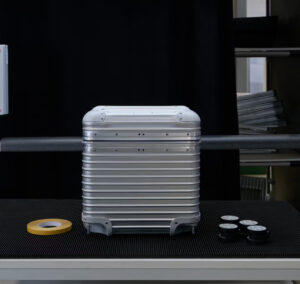
In an age where lifestyle and design are increasingly fluid, where the lines between travel, domesticity, and utility blur like never before, two iconic brands—Vitra and Rimowa—have converged in a visionary project that challenges the very idea of what luggage can be. Known respectively for their pioneering work in modern furniture design and precision-engineered travel goods, Vitra and Rimowa are no strangers to innovation. But in this collaborative reimagination, the suitcase is no longer just a vessel for movement—it becomes the furniture of modern transience.
This 2025 conceptual intervention, unveiled in a curated exhibition space that fused showroom clarity with atelier intimacy, repositions Rimowa’s aluminum suitcases as adaptable furniture pieces. The collection features a series of customized Rimowa bodies retrofitted with upholstered seat cushions—converting them into stools, benches, and low tables. It’s a modular, mobile response to contemporary life’s emphasis on hybrid usage and aesthetic flexibility.
Industrial Elegance: Material Interplay and Structural Integrity
The core of this project is built upon the unyielding sophistication of Rimowa’s signature grooved aluminum shell, a design that has achieved cult status in travel gear since the early 20th century. In this reinterpretation, the aerospace-grade aluminum casing retains its pristine industrial sheen—cool, machined, and eternally modern. What’s added is a radical sense of intimacy and tactile softness through Vitra’s upholstery program.
Here, texture and temperature meet in tension and harmony: cold metal base, warm woven fabric top. The padded seats are surfaced in finely gridded textiles that echo mid-century Eames palettes—emerald green, sky blue, sand beige—extending a color story rooted in both domestic softness and modernist discipline. Each cushion is bordered with tight piping and affixed with precision to maintain the symmetry and integrity of the Rimowa form.
The result is an object that wears its duality with poise: part aircraft fuselage, part reading nook. The rigorous formality of German manufacturing is disarmed by the visual comfort of Swiss design theory. The synergy isn’t just aesthetic—it’s symbolic.
What does it mean to turn luggage into furniture?
The Vitra x Rimowa collaboration posits a future where nomadism is no longer antithetical to domesticity. For digital nomads, short-term renters, creatives between cities, and workers in transit, the furniture they interact with needs to be as portable, modular, and reliable as their devices. These suitcase-seats are easy to ship, stack, repurpose, or store—furniture as infrastructure for a roaming life.
In a post-pandemic world that values space optimization, rapid reconfiguration, and hybrid environments, this collaboration addresses a rising demand: how can we feel at home in the in-between? Rimowa’s shell becomes more than a container of possessions—it becomes a micro-architecture, a host of both personal contents and bodily rest.
The stool is no longer just for the corner of a room—it is a literal conversation piece about movement and modernity. You sit on it not just because it’s convenient, but because it signifies that you belong to a generation that lives between places.
Process and Execution: Design Precision from Two Titans
The execution of the project reveals a meticulous design process. Rimowa’s manufacturing legacy—defined by aircraft-grade anodized aluminum, engineered grooves for structural durability, and proprietary wheel-and-hinge systems—was left intact. Instead of puncturing or dismantling the core form, Vitra approached the intervention with surgical respect.
Using modular upholstery elements, Vitra integrated seats without compromising the structural logic of the luggage. Each seating panel is constructed of high-density foam, sheathed in Kvadrat textile blends, and calibrated to fit exactly atop the flat section of the cabin-sized Rimowa case. The cushions are affixed using recessed industrial fasteners or adhesive Velcro systems, allowing easy removal without damage.
This modularity is no accident—it aligns with Vitra’s legacy of systems-thinking, seen in their adaptable office environments, reconfigurable lounge furniture, and stackable chairs. In the hands of Vitra’s designers, the Rimowa case transforms from a single-function object into multivalent furniture.
The side handles become natural anchor points for moving the unit from room to room. The legs are the wheels; the base is self-reinforcing. No added materials were needed to stabilize the units—such is the robust geometry of the original Rimowa build.
A Visual Language of the Mobile Interior
The visual field presented in the collection is deliberate. Viewed from above, the compact grid-like layout of the Rimowa suitcases—topped with textile squares—resembles a color-coded matrix of functional design. The soft matte weave of the upholstery complements the metallic cool of the cases, bringing both warmth and contrast. The uniformity of the grid is offset by tonal diversity, creating a rhythm in material and hue.
This isn’t luggage. This is a visual poem on mobility as aesthetics.
Placed in tight configurations, these modified cases create impromptu seating clusters: one could imagine them in boutique hotels, airport lounges, temporary office installations, or even art fair pavilions. The collection doesn’t aim for domestic permanence, but rather a temporary comfort that carries with it the precision of intentional design.
Conceptual Resonance: The Bauhaus of Travel
This collaboration aligns closely with Bauhaus ideals: form follows function, material honesty, and multi-functional design. It also takes cues from more contemporary philosophies—Rem Koolhaas’s “Elements of Architecture,” Dieter Rams’ reductionist clarity, or even Virgil Abloh’s deconstructionist repurposing. In many ways, Vitra x Rimowa feels like an architectural response to today’s shifting boundaries between public and private, local and global, analog and digital.
In this light, the transformed suitcase becomes a symbol—not just of travel, but of elevated transience. It poses a question central to modern life: how can we inject softness, stability, and identity into even the most utilitarian of objects?
Beyond the Object: The Future of Mobile Living
The larger implications of this collaboration stretch far beyond the gallery. As cities densify and living spaces shrink, furniture must become lighter, more mobile, more adaptable. The rise of mobile offices, travel-centric professions, and nomadic lifestyles demands new categories of living tools.
Vitra and Rimowa have not just designed a furniture piece—they’ve launched a category. The suitcase seat, or the furniture-luggage hybrid, could inspire future product lines: fold-out beds from carry-ons, workstations embedded in rolling trunks, transformable hospitality gear. These ideas aren’t speculative—they’re extensions of a logic that already exists in this collaboration.
A Vision of Designed Transience
The Vitra reconsideration of Rimowa suitcases as furniture is not a gimmick. It is a profound meditation on how we live today—and how we might live tomorrow. It affirms that even the most function-bound object can be reconsidered, that design can reconcile the industrial and the intimate, the portable and the personal.
In a cultural moment obsessed with permanence, this project offers a counterpoint: that which moves can also belong. Through disciplined design and poetic intent, Vitra and Rimowa remind us that the future of furniture is not static. It rolls with us.
No comments yet.









